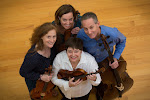The process of “study” is a wonderful journey. As familiarity with a subject becomes more intense, its meaning becomes clearer and richer. And as performers work into the details they find the essence of the style, structure and coherence that lies within every great work! I always took that saying “the devil is in the details” to mean that the most challenging part of playing a piece well lies in getting the details to speak and be heard!
I have equated this the experience, on some more simple level, to doing a jigsaw puzzle that replicates a great work of art or a photograph of an intricate scene. When I begin, I am primarily just matching color schemes, or connecting the most obvious and distinctive lines. But, as I get further into the process, I find myself studying the subtle nuances of the subject and getting to know the painting or photograph in great detail. My appreciation for its elements increases and my understanding of it becomes more complete. I see things to which I was initially blind – textures, figures, lines, shades of color.
Studying and mastering a musical work has something in common with this process. As I get to know a work and become more and more familiarized with the details of its elements of construction, it jumps to life at a whole new level! The process of understanding a work more and more in its intricate detail is enormously gratifying!
It is as if time slows down and I can hear the piece with more and more attention to the smallest figures. It feels as if my ears get bigger in the process – equivalent to seeing something through a magnifying glass - and I hear the elements in greater detail and I tune-in more keenly to the turn of a phrase, the articulation, the intonation of chords and scale patterns, and the unique structure and inflection of each motive and line.
Whoever it was who famously said, “the devil is in the details” (and later someone modified to say “God is in the details”), they made a compelling point. I think this is the “artist’s comment” about how attention to the intricacies elevates one’s experience of studying, playing, performing and/or listening to music! The sharper and closer is one’s perception of its elements, the more intimately we “know it”, the more deeply we experience all that it has to offer.
When a teen-ager listens over and over to his favorite song, I am sure it is not with the idea that the song is being “studied”. But I would maintain that it is exactly what is happening – with the result that the more one intently listens, the better one hears! The better one hears, the more one experiences the universe within a single musical selection.
Whether formal and “serious” or casual and for the “hobbyist”, “study” is what leads to a more and more thrilling understanding of a work of music. Familiarity is key to comprehension. So – the moral of the story is: listen often and listen intently - with your ears wide open! And, enjoy the journey to the center of each musical universe!!
-Kate
